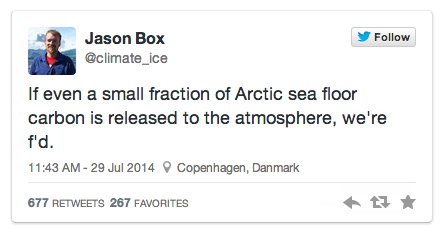 (Credit: akphotoc/Shutterstock)
(Credit: akphotoc/Shutterstock)
Climate scientist drops the F-bomb after startling Arctic discovery
There’s nothing like Twitter to take a complicated issue and force you to break it down to its essence. In a case where scientists in the Arctic discovered massive plumes of methane escaping from the seafloor, climatologist and Arctic expert Jason Box sums that essence up thusly:
The study concerns the large deposits of methane (CH4) — a greenhouse gas over twenty times more potent than CO2 — known to be buried beneath the Arctic. Stockholm University researchers found that some of that methane is leaking, and even making it to the ocean’s surface. They called the discovery “somewhat of a surprise,” which, according to Box, doesn’t quite communicate its importance. Motherboard senior editor Brian Merchant, sensing an opportunity to speak climate in more accessible language, followed up with Box, who stood by his assertion (and use of foul language):
“Even if a small fraction of the Arctic carbon were released to the atmosphere, we’re fucked,” he told me. What alarmed him was that ”the methane bubbles were reaching the surface. That was something new in my survey of methane bubbles,” he said.
“The conventional thought is that the bubbles would be dissolved before they reached the surface and that microorganisms would consume that methane, and that’s normal,” Box went on. But if the plumes are making it to the surface, that’s a brand new source of heat-trapping gases that we need to worry about.
“The Arctic is our most immediate carbon concern,” Box said, referring also to the CH4 escaping from the melting permafrost. But the sentiment can be expanded to all of climate change:
“We’re on a trajectory to an unmanageable heating scenario, and we need to get off it,” he said. “We’re fucked at a certain point, right? It just becomes unmanageable. The climate dragon is being poked, and eventually the dragon becomes pissed off enough to trash the place.”
SWERUS-C3: First observations of methane release from Arctic Ocean hydrates
Just a week into the sampling program and SWERUS-C3 scientists have discovered vast methane plumes escaping from the seafloor of the Laptev continental slope. These early glimpses of what may be in store for a warming Arctic Ocean could help scientists project the future releases of the strong greenhouse gas methane from the Arctic Ocean.

”This was somewhat of a surprise,” writes chief scientist Örjan Gustafsson, Stockholm University, in his latest blog entry. He speculates that the leaking methane from the seafloor of the continental slope may have its origins in collapsing “methane hydrates,” clusters of methane trapped in frozen water due to high pressure and low temperature.
Watch movie on methane bubbles at SWERUS Youtube channel. (Filmed by Pete Hill.)
The discovery was made while the icebreaker Oden crosscut the Laptev Sea along a depth gradient from 1000m to just 100m following the continental slope upward to reach the shallow waters of the outer Laptev Sea Shelf. By use of acoustic techniques and geochemical analyses of water samples, the scientists found vast methane plumes escaping from the seafloor at depths between 500 m and 150 m. At several places, the methane “bubbles“ even rose to the ocean surface. What’s more, results of preliminary analyses of seawater samples pointed towards levels of dissolved methane 10-50 times higher than background levels.
“While there has been much speculation about the vulnerability of regular marine hydrates along the continental slopes of the Arctic rim, very few actual observations of methane releases due to collapsing marine hydrates on the Arctic slope have been made,” writes Örjan Gustafsson.

Örjan Gustafsson thinks that the mechanism behind the presence of methane seeps at these depths may have something to do with the ”tongue” of relatively warm Atlantic water, presumably intruding across the Arctic Ocean at 200-600 m depths.” Some evidence have shown that this water mass has recently become warmer. As this warm Atlantic water, the last remnants of the Gulf Stream, propagates eastward along the upper slope of the East Siberian margin, it may lead to destabilization of methane hydrates on the upper portion of the slope. This may be what we are now seeing for the first time,” writes Örjan Gustafsson.
Mapping the bottom of the deep ocean
SWERUS-C3 scientists could determine the depth from which methane plumes were bubbling up with the help of precise sonar instruments commonly used to map the bottom of the deep ocean and detect gas seeps in the water column. ”We mapped out an area of several kilometers where bubbles were filling the water column at depths of 200 to 500 m,” writes Örjan Gustafsson. Additional observations include the discovery of over 100 new methane seep sites in the shallower waters of the Laptev shelf (at 60-70m depth), a likely consequence of the thawing subsea permafrost.
”SWERUS-C3 researchers have on earlier expeditions documented extensive venting of methane from the subsea permafrost system to the atmosphere over the East Siberian Arctic Shelf,” writes Örjan Gustafsson. He continues: ”On this expedition we have gathered a strong team to assess these methane releases in greater detail than ever before to substantially improve our collective understanding of the methane sources and the functioning of these systems.”
Örjan Gustafsson believes such data to be crucial for making scientific predictions of how the release of methane from the seafloor of the Arctic Ocean may take shape in the future.

Photo: Jorien Vonk
